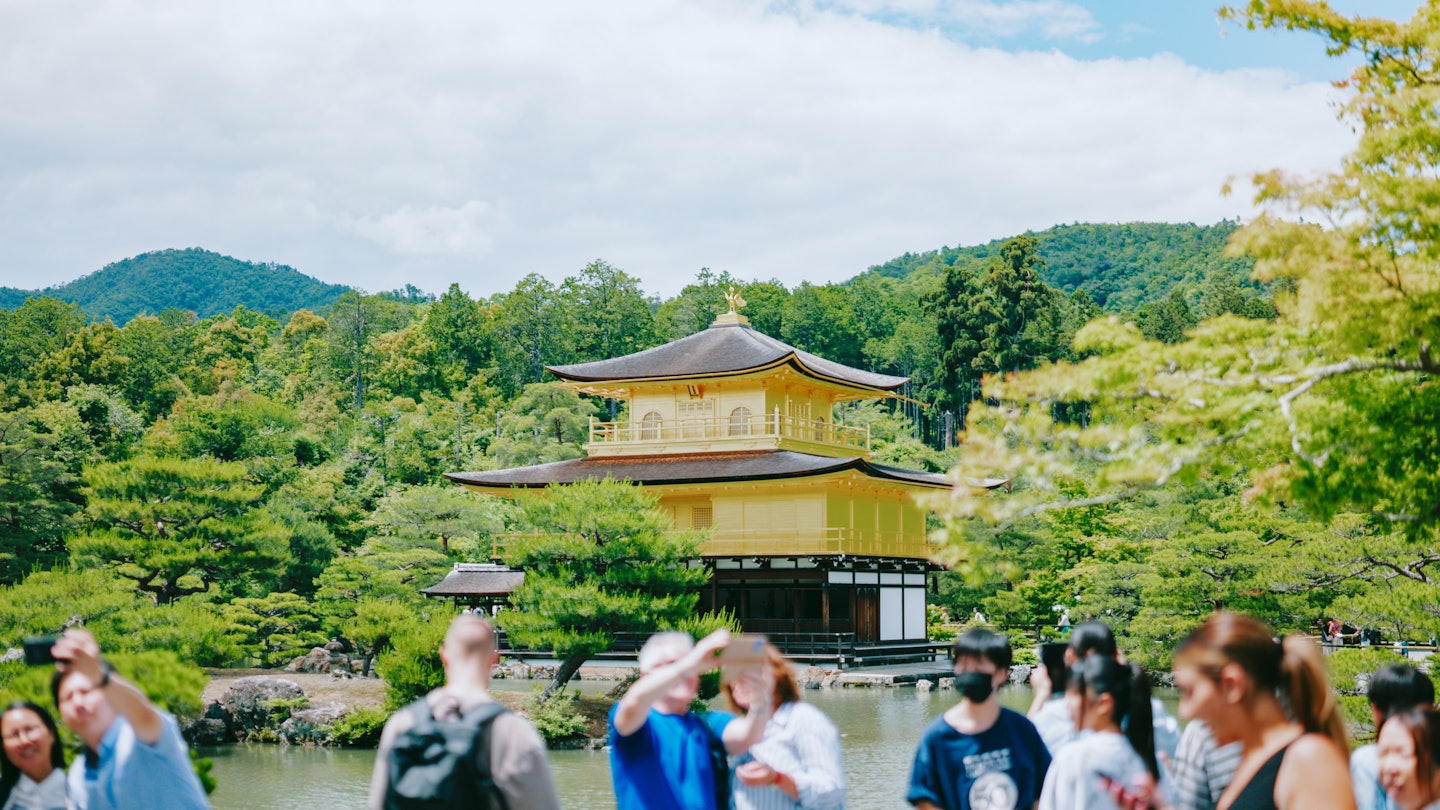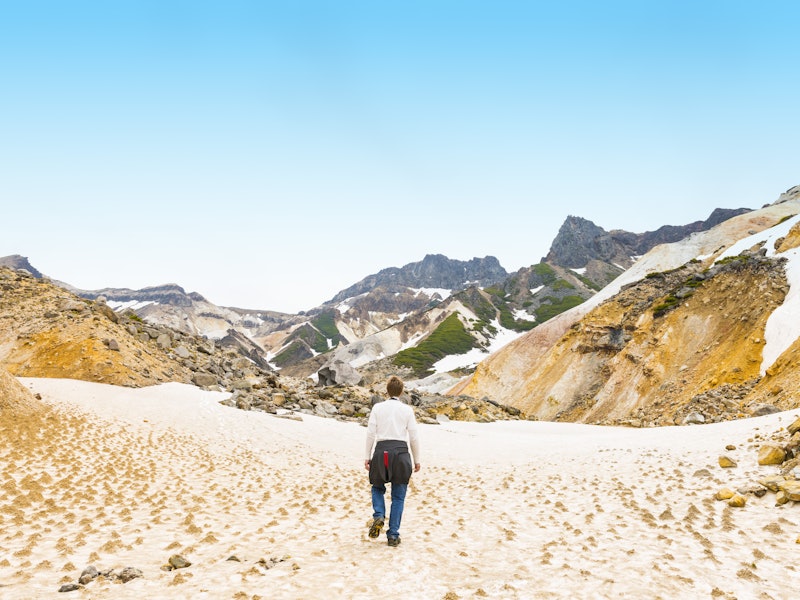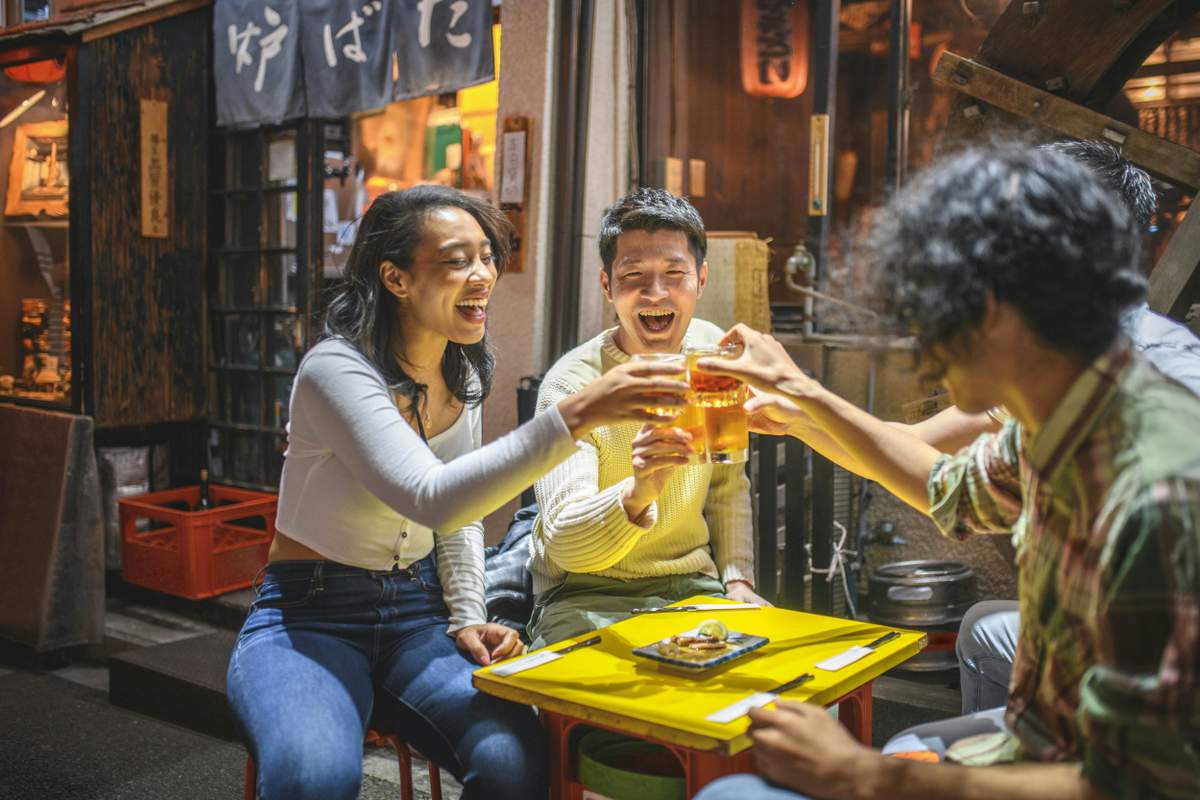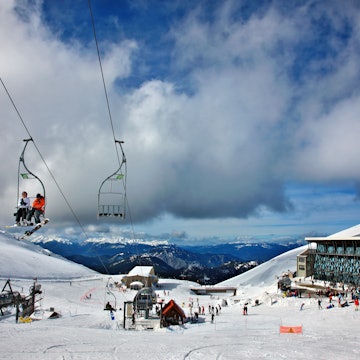

See the temples of Kyoto on a perfect Japan itinerary. Rintaro Kanemoto for Lonely Planet
Modern cities buzzing with energy, richly historic architecture, and an incredible food scene that will keep you full every step of the way – Japan truly has it all. Whether you want to road trip across its islands or jump on its famed fast trains, with a little planning, traveling around the country is a dream.
That’s why we’ve put together five itineraries that show off the best Japan has to offer. These 10-day and two-week itineraries will show off the highlights, but if you have more time, linger at the stops or combine two to build your perfect trip. Whatever you choose, plenty of adventure awaits.


1. Explore the Golden Route of Japan: a 10-day itinerary
10-day itinerary
Distance: 900km (559 miles)
This classic route for first-time visitors hits many of Japan's star attractions, can be done year-round and takes advantage of the excellent value and seamless travel offered by a Japan Rail (JR) Pass. With some time up your sleeve, purchase a longer rail pass and combine this with one of our other itineraries.
Tokyo: 3 days
Start with a few days in the capital to get over any jet lag, find your bearings and get a taste for big-city Japan. It doesn't getting any bigger than Tokyo, with skyscrapers, plenty of hustle and bustle and all those lights in one of the world's busiest cities. More than any one sight, it's Tokyo itself that enchants visitors.
Next stop: Take a shinkansen (bullet train) from Tokyo to Kyoto (2.5 hours).
Kyoto: 2 days
Activate your seven-day rail pass on the morning of day four and ride the fabulous shinkansen west to the old capital, Kyoto. You'll want a couple of days here to explore one of the world's most culturally rich cities. Consider staying in Kyoto for four nights and visiting Nara and Osaka as day trips using your JR Pass.
Next stop: Take a JR Train from Kyoto to Nara (1 hour).
Nara: 1 day
Just a short hop from Kyoto, you could either visit Nara as a day trip or spend a night here, home of the Daibutsu (Great Buddha) and gorgeous Nara Park, with its roving semi-wild deer. History in Nara goes back even further than in Kyoto. It was Japan's first permanent capital and is one of the country's most rewarding destinations.
Next stop: Take a shinkansen from Nara to Osaka (30 minutes).
Osaka: 1 day
Only 20 minutes on the shinkansen from Kyoto, Osaka can also be visited on a day trip from Kyoto or as an overnight stop. This vibrant, spirited city was home of the merchant class and takes pride in shedding the conservatism found elsewhere in Japan. It's a bit brasher, interactions are peppered with playful jabs, and it's known for its exciting street food.
Next stop: Take the shinkansen from Osaka to Hiroshima.
Hiroshima: 2 days
It's an easy shinkansen ride through to Hiroshima, a name never to be forgotten in world history. The Hiroshima Peace Memorial Museum and its surrounding park attract visitors from all over the planet, commemorating the world's first atomic-bomb attack of August 6, 1945. Present-day Hiroshima is a thriving, vibrant cosmopolitan community.
Next stop: Take a JR train and a JR ferry from Hiroshima to Miyajima (1 hour).
Miyajima: 1 day
An excellent day trip or overnight trip from Hiroshima, Miyajima, with its photogenic floating shrine, is easily reached by JR Pass and JR ferry. If trying to maximize use of your rail pass, on day 10 (day seven of the rail pass), you could head back to Tokyo. On the way, consider stopping in Himeji to visit Japan's best-preserved feudal-era castle.


2. Discover Nagano and the Japanese Alps: a 10-day itinerary
10-day itinerary
Distance: 750km (466 miles)
Link your visits to Tokyo and Kyoto inland through the mountains and via Kanazawa, one of Japan's most historic and appealing cities. It can be done in either direction and while the freedom of rental wheels is likely to enhance enjoyment levels, this itinerary can be followed using public transport.
Nagano: 2 days
Find your way to the city of Nagano, either by shinkansen or rental car from Tokyo. The mountain-ringed capital of Nagano Prefecture is centered on its magnificent Zenkō-ji temple, a National Treasure founded in the 7th century. The city was home base for the 1998 Winter Olympics, and is within easy reach of the "snow monkeys".
Next stop: Take a 50-minute train ride or drive to Matsumoto (1.25 hours).
Matsumoto: 2 days
It's a short hop to vibrant Matsumoto, sitting in a fertile valley to the east of the impressive northern Japan Alps. Matsumoto-jō is Japan's oldest wooden castle and not to be missed. The city is an attractive, cosmopolitan place, worth lingering in.
Next stop: Take a train and bus or drive (both 2 hours).
Detour: If you're driving, consider going via the outdoor resort of Hakuba.
Kamikōchi: 1 day
The eyes of Japanese outdoor enthusiasts light up when Kamikōchi is mentioned. This is where it's at for hikers, and you may want to consider spending days here, up this remote valley at the base of the North Alps. The road is closed in winter, open from late April to early November; you'll have to bus in as private cars are not allowed.
Next stop: Take the bus (1.5 hours) or drive and bus (2 hours).
Takayama: 2 days
Carry on through the mountains to Takayama, a charming old post town with one of Japan's most atmospheric townscapes, boasting well-preserved wooden buildings and narrow streets, now home to galleries, sake breweries and craft shops. It's also known for its temple district and morning market. Book ahead as Takayama is not as off the beaten track as it once was.
Next stop: Take the bus or drive (both 1.5 hours).
Shirakawa-gō: 1 day
The remote mountain villages of Shirakawa-gō and Gokayama, between Takayama and Kanazawa, are famed for their farmhouses with dramatically angled thatched roofs. They hold a special place in the Japanese heart, whatever the season, and you'll have seen them in the country's tourism literature. These World Heritage-listed villages are popular; you're unlikely to get lonely.
Next stop: Take a bus (1.5 hours) or drive (1.25 hours).
Kanazawa: 2 days
Enjoy Kanazawa, a city that, in its heyday, rivaled Kyoto in its contributions to the arts. Near the Sea of Japan, Kanazawa is known for its seafood, a lasting artisan tradition and its strolling garden, Kenroku-en. This is an excellent place to shop for traditional crafts. When you're ready, take the train or drive through to Kyoto.


3. A road trip through Shikoku: a 10-day itinerary
10-day itinerary
Distance: 350km (217 miles)
The country's fourth-largest island, Shikoku is still well off the radar of most international visitors. It's used to hosting, though, as pilgrims have been walking the 88 Sacred Temples of Shikoku pilgrimage for 1200 years. This low-key island, best explored by car, may well be the highlight of your visit to Japan.
Naoshima: 1 day
Part of Shikoku's Kagawa Prefecture, in the Inland Sea between Shikoku and Western Honshū, the art island of Naoshima is for many a stepping stone between Okayama and the Shikoku mainland. See some of Japan's best art and architecture, with museums and outdoor sculptures; Yellow Pumpkin by Yayoi Kusama has become a symbol of the island.
Next stop: Take a ferry from Naoshima to Takamatsu (1 hour).
Takamatsu: 2 days
Kagawa Prefecture is nicknamed nationwide udon-ken (udon prefecture), and you'll find an udon noodle place, with the local version, known as sanuki-udon, on almost every corner. Stroll in the immaculate gardens at Ritsurin-kōen, and browse the wares in Takamatsu's covered shopping arcades and evening entertainment areas.
Next stop: Drive from Takamatsu to Konpira-san (1 hour).
Konpira-san: 2 days
Konpira-san is Shikoku's best-known Shintō shrine. Enjoy a walk in the township at the mountain's base, and if inclined, climb the steps. Close by are Zentsu-ji, Temple 75 of the 88 Sacred Temples, and if you have time, take the ropeway up to Unpen-ji, with its enthralling 500 rakan statues.
Next stop: Drive from Konpira-san to Iya Valley (2 hours).
Iya Valley: 1 day
Head over or around the mountains and into the Iya Valley, considered one of Japan's great "hidden regions". Its staggeringly steep gorges and thick mountain forests were the refuge of fleeing samurai in centuries past. Narrow, winding valley roads limit access, particularly towards the head of the valley, where you'll find Oku Iya's lovely twin kazura-bashi (vine bridges).
Next stop: Drive from Iya Valley to Kōchi City (1.5 hours).
Kōchi City: 2 days
The capital of the island's Pacific Ocean–facing prefecture is the city of Kōchi, a smart, compact place with a reputation for enjoying a good time. The people here are known for being independent and proud, survivors cut off from the rest of Japan throughout history. Visit the lovely castle, Kōchi-jō, walk the covered shopping arcades and enjoy local delicacies at Hirome Market.
Next stop: Drive 2.5 hours from Kochi city to Matsuyama.
Matsuyama: 2 days
Shikoku's largest city, Matsuyama is handsome and refined, with a hint of mainland hustle. Its magnificent castle, one of 12 "originals" in Japan, lords it over the city, with the central city and covered shopping arcades to its south. In the east is the legendary hot springs area of Dōgo Onsen. You can fly out or ferry to Hiroshima or Kyūshū from here.


4. Explore Kyūshū and Yakushima: a 10-day itinerary
10-day itinerary
Distance: 700km (435 miles)
Off the beaten track for most international visitors, Kyūshū really delivers: it’s got vibrant cities, layers of history, excellent onsen and smoking volcanoes. If you’ve been to Japan before, or want to see something totally different, this is for you. There's a JR Pass for Kyūshū, but having a car is the way to go.
Fukuoka: 2 days
Find your way to Fukuoka, the gateway to Kyūshū and its biggest city (population 1.4 million). It's easy to fly, or take the shinkansen to Hakata, Fukuoka's bullet-train hub, from the major cities on Honshū. This hip, exciting place is the "bright lights, big city" of Kyūshū, famous for its Hakata ramen, best from a streetside yatai (food cart).
Next stop: Take a train (1.5 hours) or drive (2 hours) from Fukuoka to Nagasaki.
Nagasaki: 2 days
History weighs heavily on Nagasaki, the second Japanese city destroyed by an atomic bomb. But as Japan’s only truly open port during the 200-year period of isolation from the 17th to 19th centuries, Nagasaki has a mercantile and cosmopolitan legacy that predates its historic tragedy, living on today in its festivals, food and architecture.
Next stop: Take a train and bus (4 hours) or drive (3 hours) from Nagasaki to Kurokawa Onsen.
Kurokawa Onsen: 1 day
Make a sojourn into the Kyūshū heartland at Kurokawa Onsen, one of Japan’s prettiest onsen villages, nestled on either side of a steep gorge. This is a perfect place to experience what an onsen-ryokan getaway is all about. It's not far from Mt Aso, the world's third-largest volcanic caldera, with its smoking Naka-dake crater and enthralling landscapes.
Next stop: Take a bus (3.5 hours) or drive (1.5 hours) from Kurokawa Onsen to Kumamoto.
Kumamoto: 1 day
Carry on southwest to Kumamoto, the main hub for central Kyūshū. It's deeply proud of its greatest landmark, the castle Kumamoto-jō, built in the early 1600s. Still recovering from 2016 earthquakes that killed many and destroyed thousands of homes, this is a lively city with a tempting collection of restaurants, bars and shops in the busy arcades east of the castle.
Next stop: Take a train (2 hours) or drive (2.5 hours) from Kumamoto to Kagoshima.
Kagoshima: 2 days
Head south to Kagoshima and marvel at the stunning backdrop of Sakurajima, the often-smoking volcano across the bay. This place has a personality to match its climate and has been voted Japan's friendliest city. It's known for tonkatsu (breaded pork cutlets) and shōchū (liquor). The hot sand baths at Ibusuki are close by.
Next stop: Take a fast ferry (2.5 hours) from Kagoshima to Yakushima.
Yakushima: 2 days
Magical Yakushima is 70km (43 miles) south of the Kyūshū mainland. This World Heritage-listed island has primeval, moss-strewn forests, seaside onsen and a mountainous interior that towers up to 1936m (6440ft). It has great hiking options too; the best known is to Jōmon Sugi, an ancient tree said to be thousands of years old.


5. Explore the wilds of Hokkaidō: a two-week itinerary
14-day itinerary
Distance: 950km (590 miles)
Japan’s northernmost island, Hokkaidō, has much of what you want out of Japan: steaming onsen and rugged, volcanic peaks, city lights and foodie credibility, as well as something you may not expect – the opportunity for an epic road trip. Snow falls early in Hokkaidō, so this is a June to October trip.
Hakodate: 2 days
Start here in Hokkaidō's southernmost port, reached by shinkansen from Tokyo in four hours through the underwater Seikan Tunnel, though unless you're on a rail pass, it's probably cheaper to fly. Hakodate is a charming city with a famous morning market, historic buildings – due to being one of the first ports opened to foreign shipping in the 1850s – and renowned night views.
Next stop: Pick up a rental car and drive to Tōya-ko and Noboribetsu Onsen (4 hours).
Shikotsu-Tōya National Park: 2 days
In Tōya-ko, cycle 36km (22 miles) around the caldera lake. Carry on to Hokkaidō's most famous hot-springs town, Noboribetsu Onsen. For a day trip, visit nearby Upopoy: National Ainu Museum and Park, opened in 2020, after the Ainu were finally legally recognized as an Indigenous people of Japan.
Next stop: Drive from Noboribetsu Onsen to Sapporo (2–3 hours).
Sapporo: 2 days
Get your city fix in the prefectural capital, Sapporo; with a population of two million, it's Japan's fifth-largest city. The central city has plenty of buzz, especially around the entertainment district of Susukino and Ōdori-kōen. Don't leave town without going to the Sapporo Beer Museum or trying some Sapporo ramen and jingisukan, the legendary grilled-mutton dish.
Next stop: Drive from Sapporo to Furano (2 hours).
Furano: 2 days
Furano is nicknamed heso-no-machi (Belly-Button Town) as it's at the center of Hokkaidō. Here you'll find wine and cheese tasting, fabulous flower fields and great cycling opportunities in nearby Biei. Fukiage Roten-no-yu, one of Hokkaidō's best onsen in the wild, is also close at hand. Views east of the Daisetsuzan National Park mountains make a stunning backdrop.
Next stop: Drive from Furano to Asahidake Onsen (2 hours).
Daisetsuzan National Park: 2 days
Daisetsuzan means "big snowy mountain" and Asahi-dake (2290m/7513ft) is the highest point on Hokkaidō. Climb it from the top of the ropeway (1600m/5249ft) at Asahidake Onsen in the northwest of the national park. You can stay here and also at Sōunkyō Onsen in the park's northeast. To stay at a very remote mountain lodge, head to Daisetsu Kōgen Sansō.
Next stop: Drive from Onsen to Utoro (5 hours).
Shiretoko National Park: 2 days
Continue east to World Heritage–listed Shiretoko National Park and base yourself in Utoro. The Shiretoko Peninsula is a volcanic spit of land that the Ainu referred to as "the end of the world". There are some excellent short walks and hiking, plus nature cruises that head out up the coast. Gaze out on Russian islands from Shiretoko Pass.
Next stop: Drive from Utoro to Akanko Onsen (3 hours).
Akan Mashū National Park: 2 days
It's a short drive southwest to Akan Mashū National Park, where there's plenty to check out. In the east, you'll find fascinating Iō-zan (Sulphur Mountain), the clear caldera lakes of Kussharo-ko and Mashū-ko, and a number of onsen in the wild. In the east is Akanko Onsen, where you can check out a modern-day Ainu community at the Ainu kotan (village).
















